For sprawling cities thwarted by traffic, vertiports – with passengers taking off and landing in compact, electric autonomous air taxis – might be the ideal solution. However, developers are facing questions over the necessity of implementing passenger checks and luggage scanning comparable to commercial airports. With Advanced Air Mobility (AAM) intended to be quick and convenient, the impact of major checkpoints would be substantial, so any necessary security measures must be simplified and non-intrusive.
Nicholas Ortyl, senior director of checkpoint engineering at Leidos, a leading supplier of aviation security solutions, highlights the nature of the argument: “As these vertiport hubs will be integrated into urban landscapes, security measures are essential. Personal security screening not only safeguards passengers and personnel, but will fortify public confidence in these emerging advanced transit systems. And to keep the vertiports running efficiently, a dynamic blend of cutting-edge technologies, meticulous risk assessment methodologies and a steadfast commitment to passenger privacy is needed.”
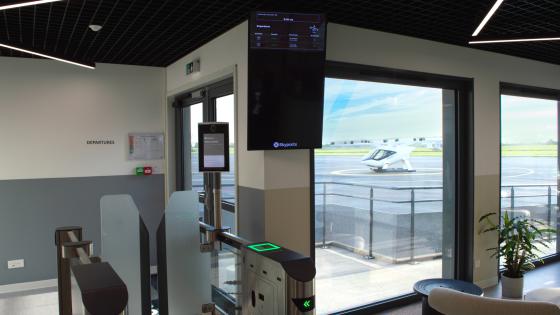
For Ankit Dass, vertiport security is likely to involve other technologies such as automation, AI and biometrics
Regional differences
For Ankit Dass, chief technology officer at Skyports, which designs, builds and operates vertiports, security is likely to involve other new technologies, such as automation, artificial intelligence (AI) and biometrics. Dass also sees the security demands of vertiports as being split into two areas: the physical side, concerning the passengers, staff and any luggage, and cybersecurity, representing technology and data: “These demands differ according to location, too. Countries in the EU are very heavy on data security, but in Dubai and Singapore they lean more into the physical side, with Singapore even telling us what the perimeter of the vertiport should look like and how high it can be. In America there’s such a big general aviation community that we hardly see any security concerns.”
Clem Newton-Brown, CEO of the Australia-based Skyportz, another company building vertiports, believes that more work is required before authorities and the community decide the level of security required: “On the one hand, we have major airports with very stringent security measures, and on the other we have small regional airports and helipads with often no security at all. Does it make sense to have security for an eVTOL [electric vertical take-off and landing] aircraft more stringent than that required for light planes and helicopters? What are the benefits versus the costs? Does it make a difference whether it is a charter flight or with mixed passengers? Can the AAM industry compete against other forms of light aviation if it has to bear the costs and time of added security? And if new security rules are required for eVTOLS, will these also be applied to other light aviation operations?
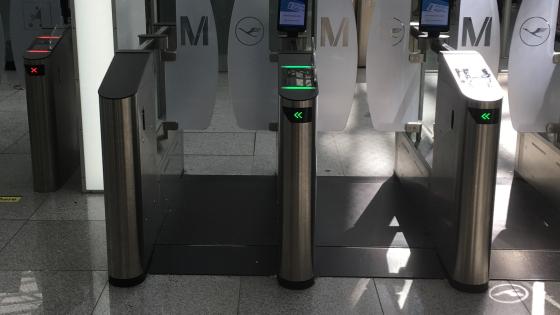
Werner Zahn believes airport security solutions will influence those of vertiports and vice versa
“The aim of AAM is to make air taxi travel more affordable and convenient. Anything that adds expense and friction to the system must be carefully evaluated on a cost/benefit basis. With the new and innovative technologies Skyportz is developing, we believe that we can provide a degree of security that is seamless and automated, but I would query whether we should automatically assume that it should be the same as that required for commercial airliners.”
Volocopter is a German air taxi developer. Its head of airspace and vertiports, Joern Jaeger, also compares the security needed at vertiports to airports: “There are certain priorities, like protecting against unauthorised access, preventing air traffic control violations and ensuring the safety of all passengers and staff. But vertiports are considerably smaller than airports and will be less crowded, so you may not address them in the same way. Effective, seamless security measures, including standard luggage control, biometric screening and a range of other technical solutions are likely to be implemented.”
Breaking it down
By looking at the areas that vertiports will need to tackle in terms of security, more can be determined about what the solutions will look like. Identifying the passenger arriving at the vertiport is the first likely step, as observed by DESKO, a provider of customised airport scanning solutions. CEO Werner Zahn said: “With our experience from three decades in the airport airline business, we can say that sovereign identity verification means nothing is left to chance. But checking the authenticity and validity of a person’s ID is not enough. It must also be ensured that the document is presented by its authorised bearer, with established self-service solutions the best choice here.”
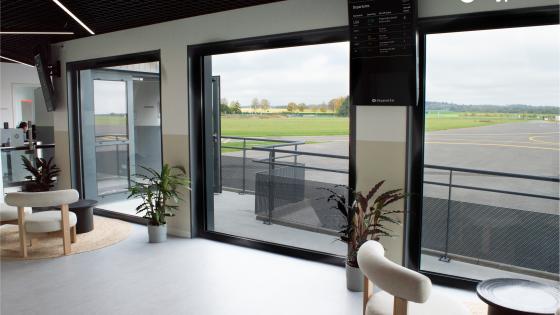
There are two key elements in vertiport security according to Skyports: the physical side, concerning passengers, staff and luggage, and cybersecurity
Confirming the identity of the traveller is also the first stage in Skyports’ security recommendations, as Dass explained: “As at an airport, you want to know who is flying and be able to authenticate them when they arrive. The person will register and book their ticket via the operator’s app, and those details would be checked against a database to verify their identity. Now, the passenger will be travelling at a certain time, so they will have a timeframe that allows entry to the vertiport, and be allowed to pass only through certain areas, with CCTV or biometrics confirming their identity. This controls the numbers of people at the location and ensures we know who they are.”
Leidos, looking at the technology it has already employed at airports, describes what might be useful in vertiports. Nicholas Ortyl told Airports International: “Advanced screening technology, such as biometric identification, including facial recognition and fingerprint scanning, could expediate the boarding process while bolstering security. There are also millimetre wave scanners, using advanced imaging technology for non-intrusive, full-body assessments of any concealed threats without compromising individual privacy. Then baggage scanners often include high-throughput explosive detection systems and AI-based algorithms to screen baggage and other personal items for anything prohibited.”
As well as passenger identification and screening, Skyports’ Ankit Dass argues the case for IT security and overseeing general vertiport operations: “We have to make sure that any cloud solution is compliant with the regulations in that particular country. At Skyports, we’ve taken the view that we’ll be ISO/IEC 27001:2013 compliant, which should give most countries confidence that we’re addressing cybersecurity. Then, on operational compliance we recommend a security process that is flexible, scaling up and down according to the likely threat. This means collecting data locally and internationally, and introducing extra measures accordingly. We also think there should be a random screening programme to mitigate those trying to work around the established processes. Depending on the threat level, the nature of the checks and frequency can also vary.”

Vertiports will be small, meaning that security data is more likely to be stored on the cloud rather than on-site
Embracing challenges
With vertiports representing a new form of transport, with much of the logistics and operations still to be defined, there will understandably be challenges when it comes to establishing security protocols. One being faced is the lack of overarching regulations and guidelines, with operators often left to decide these themselves. Volocopter’s Joern Jaeger explained: “We’ve closely engaged in developing standards and regulations by joining EASA’s task force for vertiport design guidelines. We’re also in ICAO’s vertical flight infrastructure working group, EUROCAE VTOL infrastructure and GAMA’s infrastructure group.”
Skyports’ Ankit Dass has taken a similar approach: “There’s no defined international standard for vertiport security. You have the ICAO standards for aviation, and IATA specifying certain standards for vertical operations, but nothing at that level globally. You have aircraft certification, which is controlled by bodies like the FAA and EASA to a larger extent, but when it comes to vertiports, it’s just guidelines for what you should do in terms of airfield design and operations, with nothing on airfield security.”
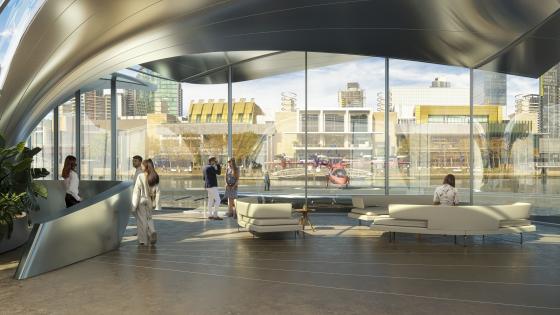
The urban locations of vertiports make security particularly important
There is also a challenge in finding security solutions that do not impact the speed or convenience of the service. “Leveraging automated, AI-based technologies will help to strike the balance,” said Leidos’s Nicholas Ortyl. “What is deployed, and how, will be determined by the security posture adopted or mandated by the market. Nobody knows yet what the regulations will be, but we can assume that security will be a high priority.”
DESKO’s Werner Zahn agrees: “Any vertiport security measures should be non-invasive. Passengers will expect a smooth, hassle-free journey. The checkpoints need to be automated, which means time savings and flexibility for all sides, but it’s also necessary to find a balance between regulation and innovation. Any standards and regulations must keep pace with this new technology.”
To ensure that operations run smoothly, regulators, operators and vertiports will all need to work together when it comes to data sharing. Skyports’ Ankit Dass observed: “That needs to happen if you’re using a database to check the identity of the passenger. Due to the efficiency required, a lot more co-operation is needed than in traditional aviation. Also, a challenge we’re anticipating is cross-border flights being offered, as then you need to add passport checks. For this we’re talking to technology companies like SITA, as we want to see if passport control can be handled using a software solution or even NFC technology. So if a passenger has their phone with them, simply walking through the checkpoints with it could give the operator everything they need.”
As flights are only expected to be over short distances initially, it is not expected that luggage checks will cause hold-ups. Volocopter’s Joern Jaeger said: “Customers are more likely to only take small bags or hand luggage, which can be checked easily, as is done at airports. Heliports don’t have a security congestion problem, because their security requirements and procedures are straightforward and their luggage policy is clear. If any regulations for vertiport security are introduced, they should be carefully considered, taking elements from existing air travel regulations, but also being flexible enough to allow security and efficiency at the same time.”
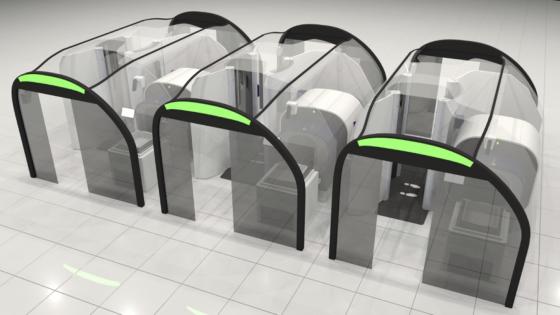
A Leidos self-service security screening pod concept
A world away from airports
What seems to be clear is that the security demands of vertiports are on a much smaller scale than regular airports, handled primarily using technology. As Nicholas Ortyl pointed out, this widens the gap when making comparisons to commercial aviation: “Vertiports will likely be used daily or weekly by repeat consumers. Passenger screening using self-service kiosks, for example, would provide a frictionless and improved experience for travellers, and security personnel would only engage if their belongings are flagged. Advancements in AI will also provide a smooth and intuitive self-service experience, especially for regular travellers accustomed to vertiport processes.”
DESKO’s Werner Zahn acknowledged the differences between vertiports and airports, but believes the security solutions of one will influence the other: “The risks are comparable. Vertiport security tech is going to benefit from all innovative developments at airports, such as smart self-service solutions or biometric checks.”
Skyports’ Ankit Dass noted that an airport is spread over a wider area, with data collected often via its own equipment: “But at a vertiport, the footprint is so small, it relies more on data sourcing, with information stored in the cloud rather than onsite. Data security at all levels will be crucial.”
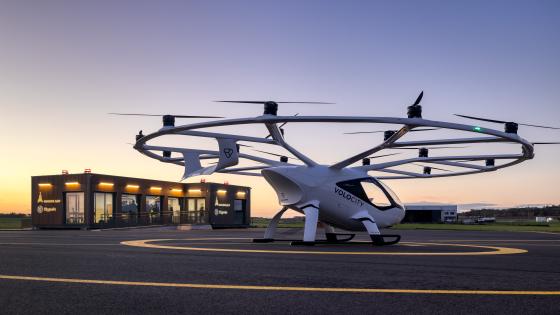
For Volocopter’s Joern Jaeger, preventing unauthorised access to vertiports is a security priority
Existing firms and emerging tech
Vertiport security is attracting emerging technology companies, but has also caught the attention of those already working with airports in this field. Skyports’ Dass confirmed: “We’re seeing a lot of interest from traditional innovation security companies, who work with banks, storage, aviation and those kinds of markets. Emerging tech companies are also competing in the space, with both sides looking for the best solutions.”
Leidos has worked with many large commercial airports around the world, and is keen to lend its expertise to vertiports, according to Nicholas Ortyl: “Leidos offers a cyber-hardened, autonomous checkpoint solution that is presently deployed to help secure a variety of critical infrastructure. It would work well in a vertiport setting, where urban air-travellers could use it on a self-service basis. We’re also experienced when it comes to scalability and addressing challenges. Our product is designed to anticipate and accommodate increased passenger traffic, while maintaining efficiency in screening processes, and we would establish interoperable security standards across vertiports and transportation networks for consistency and ease of operation. Emerging technologies such as AI, machine learning and sensors could enhance screening accuracy and agility, with a real-time analysis of passenger behaviour patterns to pre-empt threats. Also, algorithms can be used to assess passenger profiles and detect potential security risks by cross-referencing against watchlists.”
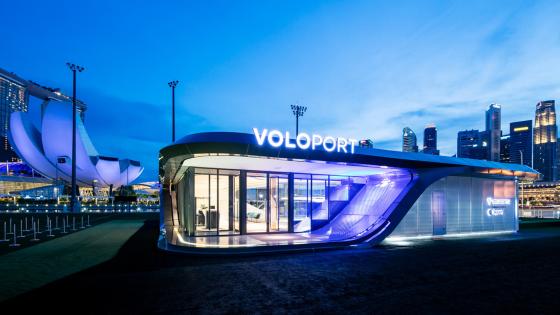
With most passengers expected to take hand-luggage only, security provisions at vertiports are expected to be seamless and unobtrusive
